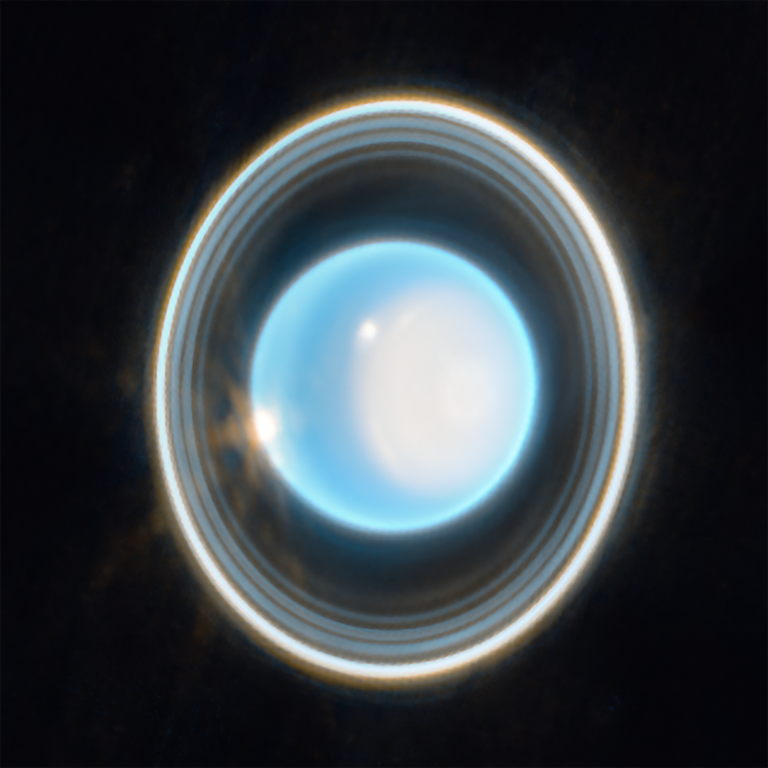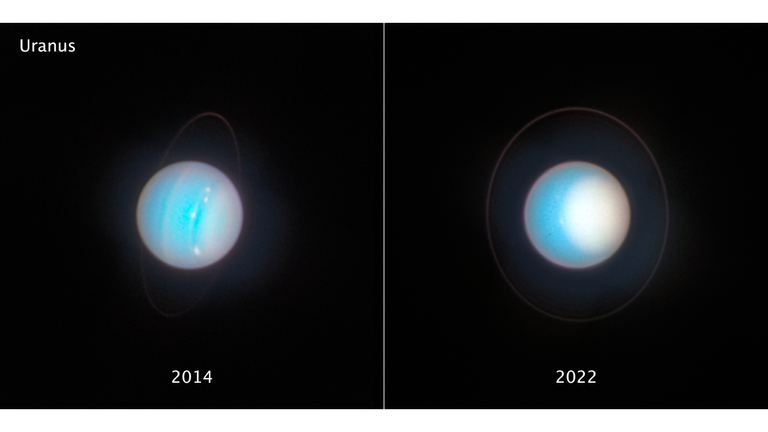
Posted on 07/24/2025 1:02:26 PM PDT by Red Badger
KEY POINTS
Jupiter, Saturn, and Neptune each emit more energy than they receive from the Sun, meaning they have comparatively warm interiors.
NASA’s Uranus flyby with Voyager 2 in 1986 found the planet colder than expected, which challenged ideas of how planets formed and evolved.
However, with advanced computer modeling and a new look at old data, scientists think the planet may actually be warmer than previously expected.
====================================================================
For millennia, astronomers thought Uranus was no more than a distant star. It wasn’t until the late 18th century that Uranus was universally accepted as a planet. To this day, the ringed, blue world subverts scientists’ expectations, but new NASA research helps puzzle out some of the world’s mystique.

This zoomed-in image of Uranus, captured by the Near-Infrared Camera on NASA’s James Webb Space Telescope on Feb. 6, 2023, reveals stunning views of Uranus’ rings. Credits: NASA, ESA, CSA, STScI
=====================================================================
Uranus is unlike any other planet in our solar system. It spins on its side, which means each pole directly faces the Sun for a continuous 42-year “summer.” Uranus also rotates in the opposite direction of all planets except Venus. Data from NASA’s Voyager 2 Uranus flyby in 1986 also suggested the planet is unusually cold inside, challenging scientists to reconsider fundamental theories of how planets formed and evolved throughout our solar system.
“Since Voyager 2’s flyby, everybody has said Uranus has no internal heat,” said Amy Simon, a planetary scientist at NASA’s Goddard Space Flight Center in Greenbelt, Maryland. “But it’s been really hard to explain why that is, especially when compared with the other giant planets.”
These Uranus projections came from only one up-close measurement of the planet’s emitted heat made by Voyager 2: “Everything hinges on that one data point,” said Simon. “That is part of the problem.”
Now, using an advanced computer modeling technique and revisiting decades of data, Simon and a team of scientists have found that Uranus does in fact generate some heat, as they reported on May 16 in the Monthly Notices of the Royal Astronomical Society journal.
A planet’s internal heat can be calculated by comparing the amount of energy it receives from the Sun to the amount it of energy it releases into space in the form of reflected light and emitted heat. The solar system’s other giant planets — Saturn, Jupiter, and Neptune — emit more heat than they receive, which means the extra heat is coming from inside, much of it left over from the high-energy processes that formed the planets 4.5 billion years ago. The amount of heat a planet exudes could be an indication of its age: the less heat released relative to the heat absorbed from the Sun, the older the planet is.
Uranus stood out from the other planets because it appeared to give off as much heat as it received, implying it had none of its own. This puzzled scientists. Some hypothesized that perhaps the planet is much older than all the others and has cooled off completely. Others proposed that a giant collision — the same one that may have knocked the planet on its side — blasted out all of Uranus’ heat. But none of these hypotheses satisfied scientists, motivating them to solve Uranus’ cold case.
“We thought, ‘Could it really be that there is no internal heat at Uranus?’” said Patrick Irwin, the paper’s lead author and professor of planetary physics at the University of Oxford in England. “We did many calculations to see how much sunshine is reflected by Uranus and we realized that it is actually more reflective than people had estimated.”
The researchers set out to determine Uranus’ full energy budget: how much energy it receives from the Sun compared to how much it reflects as sunlight and how much it emits as heat. To do this, they needed to estimate the total amount of light reflected from the planet at all angles. “You need to see the light that’s scattered off to the sides, not just coming straight back at you,” Simon said.
To get the most accurate estimate of Uranus' energy budget yet, Oxford researchers developed a computer model that brought together everything known about Uranus’ atmosphere from decades of observations from ground- and space-based telescopes, including NASA’s Hubble Space Telescope and NASA’s Infrared Telescope Facility in Hawaii. The model included information about the planet’s hazes, clouds, and seasonal changes, all of which affect how sunlight is reflected and how heat escapes.

These side-by-side images of Uranus, taken eight years apart by NASA’s Hubble Space Telescope, show seasonal changes in the planet’s reflectivity. The left image shows the planet seven years after its northern spring equinox when the Sun was shining just above its equator. The second photo, taken six years before the planet’s summer solstice, portrays a bright and large northern polar cap. Credit: NASA, ESA, STScI, A. Simon (NASA-GSFC), M. H. Wong (UC Berkeley), J. DePasquale (STScI)
====================================================================
The researchers found that Uranus releases about 15% more energy than it receives from the Sun, a figure that is similar to another recent estimate from a separate study funded in part by NASA that was published July 14 in Geophysical Research Letters. These studies suggest Uranus it has its own heat, though still far less than its neighbor Neptune, which emits more than twice the energy it receives.
“Now we have to understand what that remnant amount of heat at Uranus means, as well as get better measurements of it,” Simon said.
Unraveling Uranus’ past is useful not only for mapping the timeline of when solar system planets formed and migrated to their current orbits, but it also helps scientists better understand many of the planets discovered outside the solar system, called exoplanets, a majority of which are the same size as Uranus.
NASA’s Goddard Space Flight Center, Greenbelt, Md.
Wiping Uranus because it’s getting warm is how you get Klingons.
My uranus gets really hot after I eat spicy food.
They should have used a rectal thermometer when they had the chance.
______________________________
Thermoter: red is for rectal and blue is for oral.
Don’t let the nurse put a red thermometer in your mouth.
Disclaimer: Opinions posted on Free Republic are those of the individual posters and do not necessarily represent the opinion of Free Republic or its management. All materials posted herein are protected by copyright law and the exemption for fair use of copyrighted works.